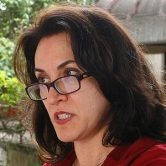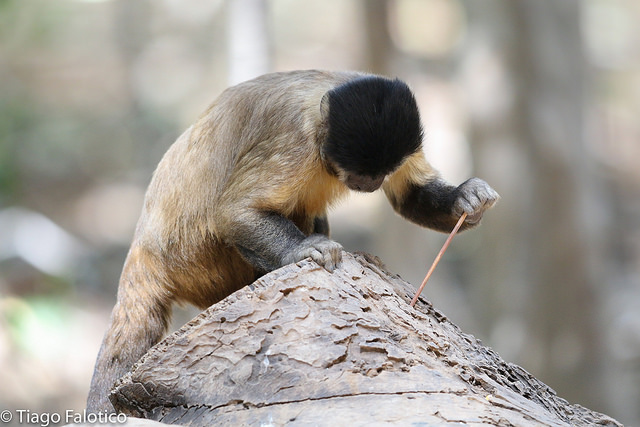
This project started in 2018 with the aim of identifying and understanding the cultural behavior of a neotropical primate, the capuchin monkey. This intelligent and curious monkey does several behaviors, including tool use, that are similar to our ancestors, although separated by 40 million years of evolutionary history. That makes capuchins an interesting alternative model to understand human evolution.
The project brought together a team of international researchers from different areas of expertise. Primatologists, geneticists, archaeologists, botanists, and biologists work together to understand why capuchin monkey populations behave so differently, although some live in similar environments.

The project’s first phase had the support of the São Paulo Research Foundation (FAPESP), National Geographic Society, and Leakey Foundation, and was based at the School of Arts, Sciences and Humanities at the University of São Paulo.
In this first phase, we mapped eight populations of robust capuchin monkeys and identified tool use behaviors in new populations.
In 2024, the project was selected as part of the new Wildlife Intelligence Project, funded by the National Geographic Society and John Templeton Foundation, as an initiative to support research on animal intelligence.

The project is now based at Neoprego and will set up long-term research bases at Serra da Capivara and Ubajara.
Aims
The current project phase aims to compare two (and potentially more) populations of capuchins monkeys to understand the diversity in tool use behavior and other behaviors, and the factors affecting the presence, variance, and development of those behaviors. We will collect data to study ontogeny and proximate factors affecting probe tool use and its sex bias. We also want to understand the “flake” production by some of the stone tool-use behaviors and use that to discuss the emergence of flake production in the human lineage.
Main questions
- Are ecological factors the main ones leading to the tool use differences?
- Is the genetic difference significant between the populations? Can it explain some of the tool-use variances?
- Which tool-use behaviors could be cultural traits?
- Is cultural diversity the same between populations?
- How are the capuchin “flakes” created, and are they different between populations?
- How long did stone tool use and flake production by capuchins occur in each population?
- How is the development of probe tool use behavior in those populations?
- Is probe tool use behavior sex bias linked to low food return?
People
The project is composed of a highly trained team of scientists from different backgrounds, joining to study this topic, some of them also members of Neoprego.
PRINCIPAL INVESTIGATOR
DR. TIAGO FALÓTICO 

Tiago is a biologist, ethologist and primatologist. He is a National Geographic Explorer and one of the founders of the NGO Neotropical Primates Research Group (Neoprego).
He has studied wild capuchin monkeys and other primates for over 20 years and is now leading the long-term CapCult project. His studies about capuchin monkeys at Serra da Capivara National Park were the starting point for this project. This population has the most complex and diverse tool-use behavior for capuchin monkeys known to date, and it is the initial comparison for the other study sites of the project.
RESEARCHERS
PROF. DR. MARIA CÁTIRA BORTOLINI 

Biologist and geneticist with great experience in populations genetic diversity, genomic ancestrality and peopling of the Americas. She is a full professor at Rio Grande do Sul Federal University. Her team will study the genetic variance between and within the study populations.
Dr. Tomos Proffitt 

Tom is a Palaeolithic archaeologist with a background in lithic analysis, GIS analysis, and experimental archaeology. He runs and conducts archaeological fieldwork in various parts of the globe. He is interested in exploring diachronic and synchronic lithic variation in the Palaeolithic archaeological record to better understand early hominin technology, technical expertise, and land use patterns.
In addition to this, since 2016, he has been involved in developing the new field of primate archaeology. He is especially interested in fields of primate tool use and early hominin percussive technology. He currently conducts long-term capuchin primate archaeology fieldwork in Serra da Capivara National Park in Brazil, which is centered on understanding the archaeological signature of capuchin stone tool use.
STUDENTS
MSC. TATIANE VALENÇA 

Tati Valença is a biologist, ethologist, and primatologist. She has a Master in Animal Behavior and is a doctoral student at the University of São Paulo. She is currently in a collaborative period at the Universität Konstanz and is a guest researcher at the Max Planck Institute of Animal Behavior in Konstanz, Germany. Her broad interests are in ecology and conservation of animal culture.
She began to study capuchin monkeys in 2013 during her bachelor’s studies. She has been in the CapCult Project since the beginning, working as a technician in 2019/2020, collecting and analysing behavioural and ecological data in several field sites. Since 2020, she has been studying in more detail the bearded capuchin monkeys of Ubajara National Park, describing their tool use repertoire and investigating the role of terrestriality in tool use.
MSC. Henrique Pereira Rufo 

Henrique is a biologist and primatologist with research in Animal Behavior, focusing on tool use and social learning in capuchin monkeys. During his master’s degree in Experimental Psychology at the University of São Paulo (USP), he developed research with an experimental task focused on the innovative use of stick tools and the social learning mechanisms involved in the diffusion of the task solution. Henrique is currently a doctorate student at the same department researching the ontogeny and social learning of the behavior of stone tool use for digging by capuchin monkeys at Serra da Capivara National Park, Piauí. He also has an interest in animal culture and comparative studies.
BSC. GABRIELA DE OLIVEIRA AFFONÇO

Gabriela is a biologist and worked as a research assistant during 2022/2023, collecting behavioural data of tool use by the bearded capuchins of Ubajara National Park. She is currently a master student at the Museum of Archaeology and Ethnology of the University of São Paulo, where she is studying lithic fragments of capuchin monkey tools from the Ubajara National Park and Serra da Capivara National Park. This study includes morphological and technological analysis of the objects, in addition to biomechanical analysis of nut-cracking and stone-on-stone behaviorsl.
ALUMNI
People who contributed to the project in the past years.
- Amanda Christina Macedo
- Andrews Michel F. Oliveira Nunes
- Beatriz Cabrera Santana
- Giulia Sirianni
- Guilherme Henrique Mugnaini
- Luiza Gonzalez Ferreira
- Mariana D. Fogaça
- Matheus Albertin De Jesus
- Michele P. Verderane
- Paulo Henrique M. Coutinho
- Tatiana Espinola
- Vivian Heloise Tavares de Sousa
Publications and outcomes
The outcomes of this project are listed in the Publications page.
Grants
This project is currently funded by:

Previous project funders included São Paulo Research Foundation (FAPESP), The Leakey Foundation, and Marie Skłodowska-Curie Actions.















